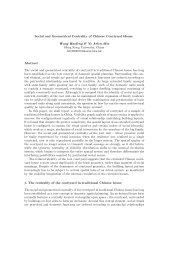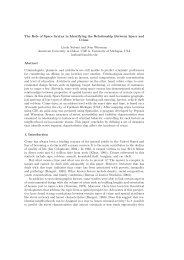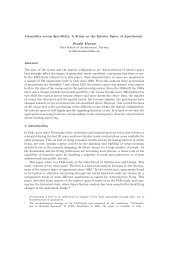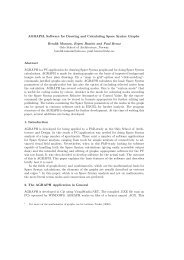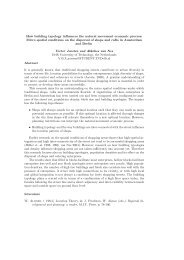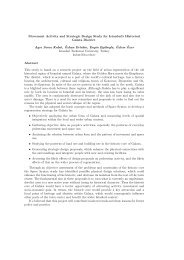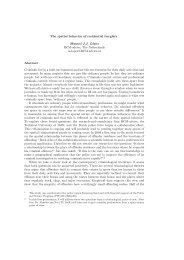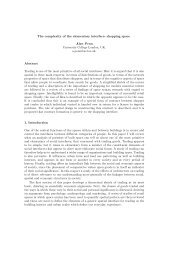High Resolution Analysis of Crime Patterns in Urban Street Networks
High Resolution Analysis of Crime Patterns in Urban Street Networks
High Resolution Analysis of Crime Patterns in Urban Street Networks
Create successful ePaper yourself
Turn your PDF publications into a flip-book with our unique Google optimized e-Paper software.
452 B. Hillier and O. SahbazUniversity <strong>of</strong> London 2000). What is needed is high resolution analysis <strong>of</strong> crime patterns<strong>in</strong> urban street networks <strong>in</strong> which these issues are variables to beg<strong>in</strong> to build the body <strong>of</strong>evidence needed to decide these issues. In this paper we propose such a high resolutiontechnique. The unit <strong>of</strong> analysis is the segment <strong>of</strong> a street between junctions, and thetechnique comb<strong>in</strong>es space syntax analysis with Geographical Information Systems (GIS).In contrast to most available crime analysis packages, which focus on the cluster<strong>in</strong>g<strong>of</strong> crime <strong>in</strong> particular locations, space syntax research has po<strong>in</strong>ted to the importance <strong>of</strong>look<strong>in</strong>g at non-clustered patterns, that is the k<strong>in</strong>ds <strong>of</strong> locations <strong>in</strong> which certa<strong>in</strong> k<strong>in</strong>ds<strong>of</strong> crime occurred, but which are dispersed throughout the grid and so do not appear asclusters or ‘hot-spots’. By comb<strong>in</strong><strong>in</strong>g space syntax with the data handl<strong>in</strong>g capabilities <strong>of</strong>GIS, a flexible method <strong>of</strong> analysis can be developed which works at the high resolutionlevel required, but can also work at higher levels <strong>of</strong> aggregation such as the Output Area<strong>of</strong> the 2001 Census or the adm<strong>in</strong>istrative divisions <strong>in</strong>to wards.Previous space syntax studies have confirmed some <strong>of</strong> the pr<strong>in</strong>ciples <strong>of</strong> the prevail<strong>in</strong>gdefensible space orthodoxy, but has also opened up a positive w<strong>in</strong>dow on certa<strong>in</strong> newurbanist propositions. For example, syntax studies <strong>of</strong> residential burglary have confirmedthat when embedded <strong>in</strong> an urban street network, simple l<strong>in</strong>ear cul-de-sacs can <strong>of</strong>ten bethe safest places, but that when the cul-de-sac is generalised <strong>in</strong>to a design pr<strong>in</strong>ciple sothat whole areas take the form <strong>of</strong> a hierarchy <strong>of</strong> cul-de-sacs, the effects can be quite theopposite (Hillier and Shu 2000, Hillier 2004). It has also shown that <strong>in</strong> residential areas,the streets that are most <strong>in</strong>tegrated - and therefore with more natural movement- are<strong>of</strong>ten safer than the more broken up spaces, but that where <strong>in</strong>tegrated streets have ‘localvulnerability’; for example through ‘secondary exposure’ through alleys or adjacent openareas, or basement access, then <strong>in</strong>tegrated streets can become s<strong>in</strong>gularly vulnerable. Wecall these switches ‘flip over effects’ to express the idea that design variables do not act<strong>in</strong>dependently, but <strong>in</strong>teract, so that all must be got right together if there is to be agenu<strong>in</strong>e reduction <strong>in</strong> vulnerability. Equally complex results have come from look<strong>in</strong>g atcrimes aga<strong>in</strong>st the person <strong>in</strong> urban areas, with patterns <strong>of</strong> crime shift<strong>in</strong>g with time <strong>of</strong> dayand thus with the presence <strong>of</strong> greater or lesser degrees <strong>of</strong> movement (Alford 1996).But space syntax has not so far studied patterns <strong>of</strong> crime either at the much largerscales <strong>of</strong> the city and its multiplicity <strong>of</strong> socially and spatially differentiated areas, or with afull analysis at the high resolution level <strong>of</strong> the street segment. In this paper we seek remedythis deficiency by report<strong>in</strong>g the first results <strong>of</strong> a space syntax study <strong>of</strong> crime <strong>in</strong> the streetnetwork <strong>of</strong> an entire London borough, with 99,991 households and 263,464 people with<strong>in</strong>its boundaries (accord<strong>in</strong>g to Census 2001). We have been given access to a 5 year crimedata base <strong>in</strong> which every crime has been located and by l<strong>in</strong>k<strong>in</strong>g this to a space syntaxanalysis <strong>of</strong> the whole borough (<strong>in</strong> the context <strong>of</strong> its urban surround<strong>in</strong>gs), and l<strong>in</strong>k<strong>in</strong>g bothto social and demographics data available from the 2001 census, as well as the Borough’sown property database, we have perhaps the largest and best body <strong>of</strong> spatial, sociodemographicsand crime data yet brought together <strong>in</strong> a s<strong>in</strong>gle study. As an extra bonus,the fact that the London borough <strong>in</strong> question is largely made up <strong>of</strong> traditional hous<strong>in</strong>gon a street network, makes this data base ideal for pos<strong>in</strong>g the key current questions as tohow street networks and their function<strong>in</strong>g shape the pattern <strong>of</strong> crime. But we should alsoissue a ‘health warn<strong>in</strong>g’. The London borough <strong>in</strong> question is socially and ethnically highlyvaried, and differentiated physically between its <strong>in</strong>ner, more ‘<strong>in</strong>ner city’, and outer, moresuburban, areas. Some <strong>of</strong> its centres are already known as high crime areas. We should becareful not to generalise its results prematurely, before a range <strong>of</strong> such studies have beenmade <strong>in</strong> different cities.



